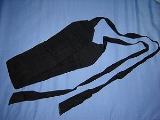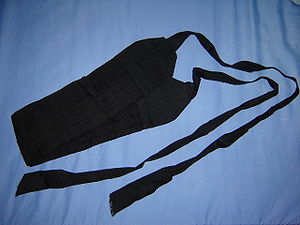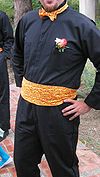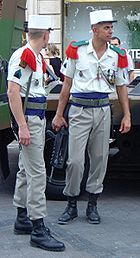
Cummerbund
Encyclopedia

Sash
A sash is a cloth belt used to hold a robe together, and is usually tied about the waist. The Japanese equivalent of a sash, obi, serves to hold a kimono or yukata together. Decorative sashes may pass from the shoulder to the hip rather than around the waist...
, usually pleat
Pleat
A pleat is a type of fold formed by doubling fabric back upon itself and securing it in place. It is commonly used in clothing and upholstery to gather a wide piece of fabric to a narrower circumference....
ed, which is often worn with single-breasted dinner jackets (or tuxedos). The cummerbund was first adopted by British
British Empire
The British Empire comprised the dominions, colonies, protectorates, mandates and other territories ruled or administered by the United Kingdom. It originated with the overseas colonies and trading posts established by England in the late 16th and early 17th centuries. At its height, it was the...
military officers in colonial India
India
India , officially the Republic of India , is a country in South Asia. It is the seventh-largest country by geographical area, the second-most populous country with over 1.2 billion people, and the most populous democracy in the world...
as an alternative to a waistcoat
Waistcoat
A waistcoat or vest is a sleeveless upper-body garment worn over a dress shirt and necktie and below a coat as a part of most men's formal wear, and as the third piece of the three-piece male business suit.-Characteristics and use:...
, and later spread to civilian use. The modern use of the cummerbund is as a component of the semi-formal black tie
Black tie
Black tie is a dress code for evening events and social functions. For a man, the main component is a usually black jacket, known as a dinner jacket or tuxedo...
dress code.
Origin of the name
The word Cummerband which entered English vocabulary in 1616 via languages of the Indian subcontinentIndian subcontinent
The Indian subcontinent, also Indian Subcontinent, Indo-Pak Subcontinent or South Asian Subcontinent is a region of the Asian continent on the Indian tectonic plate from the Hindu Kush or Hindu Koh, Himalayas and including the Kuen Lun and Karakoram ranges, forming a land mass which extends...
such as Hindi and Urdu, is originally a Persian
Persian language
Persian is an Iranian language within the Indo-Iranian branch of the Indo-European languages. It is primarily spoken in Iran, Afghanistan, Tajikistan and countries which historically came under Persian influence...
genitive phrase comprising kamar (waist) + band (band).
The word cummerband (see below), and less commonly the German spelling kummerbund (translating to 'ribbon of sorrow'), are often used synonymously with cummerbund in English. Today, the word kamarband in Persian simply refers to anything which is or works like a typical clothing belt
Belt (clothing)
A belt is a flexible band or strap, typically made of leather or heavy cloth, and worn around the waist. A belt supports trousers or other articles of clothing.-History:...
.
Description

Velcro
Velcro is the brand name of the first commercially marketed fabric hook-and-loop fastener, invented in 1948 by the Swiss electrical engineer George de Mestral...
.
In contemporary use, it is now common to see coloured bow ties and cummerbands, often matching, but this is still condemned by dress authorities. They have also expanded in less formal situations into use with components of white tie, particularly by musicians, who sometimes wear a white cummerbund instead of the traditional marcella
Pique
Piqué, or marcella, refers to a weaving style, normally used with cotton yarn, which is characterized by raised parallel cords or fine ribbing. Twilled cotton and corded cotton are close relatives....
waistcoat.
'The Cummerbund' is also a nonsense poem by Edward Lear
Edward Lear
Edward Lear was an English artist, illustrator, author, and poet, renowned today primarily for his literary nonsense, in poetry and prose, and especially his limericks, a form that he popularised.-Biography:...
, fully titled 'The Cummerbund, a poem from India', where it refers to the cummerbund as a ferocious woman-eating beast.
Military cummerbunds

Army of Africa (France)
The Army of Africa was an unofficial but commonly used term for those portions of the French Army recruited from or normally stationed in French North Africa from 1830 until the end of the Algerian War in 1962.-Composition:...
(such as the Zouaves or the Chasseurs d'Afrique
Chasseurs d'Afrique
The Chasseurs d'Afrique were a light cavalry corps in the French Armée d'Afrique . First raised in the 1830s from regular French cavalry posted to Algeria, they numbered five regiments by World War II...
) wore cummerbunds of 2 different colours : blue for European soldiers and red for Native recruits. Some current French regiments, related to the French colonial history
French colonial empire
The French colonial empire was the set of territories outside Europe that were under French rule primarily from the 17th century to the late 1960s. In the 19th and 20th centuries, the colonial empire of France was the second-largest in the world behind the British Empire. The French colonial empire...
, still retain cummerbunds as part of their full dress uniform (notably the French Foreign Legion and the Spahi
Spahi
Spahis were light cavalry regiments of the French army recruited primarily from the indigenous populations of Algeria, Tunisia and Morocco. The modern French Army retains one regiment of Spahis as an armoured unit, with personnel now recruited in mainland France...
s).
Similar to the cummerbund, a cummerband is an accessory to the dress uniform
Military uniform
Military uniforms comprises standardised dress worn by members of the armed forces and paramilitaries of various nations. Military dress and military styles have gone through great changes over the centuries from colourful and elaborate to extremely utilitarian...
used extensively in both the modern Indian Army
Indian Army
The Indian Army is the land based branch and the largest component of the Indian Armed Forces. With about 1,100,000 soldiers in active service and about 1,150,000 reserve troops, the Indian Army is the world's largest standing volunteer army...
and Pakistan Army
Pakistan Army
The Pakistan Army is the branch of the Pakistani Armed Forces responsible for land-based military operations. The Pakistan Army came into existence after the Partition of India and the resulting independence of Pakistan in 1947. It is currently headed by General Ashfaq Parvez Kayani. The Pakistan...
. This sash
Sash
A sash is a cloth belt used to hold a robe together, and is usually tied about the waist. The Japanese equivalent of a sash, obi, serves to hold a kimono or yukata together. Decorative sashes may pass from the shoulder to the hip rather than around the waist...
-like item traces its origin to the uniforms of the Indian regiments raised during the period of British rule. It is generally worn during ceremonial parades and dinners. Like the cummerbund it is a long strip of cloth which is tightly worn around a soldier's waist. The colour or combination of colours varies widely according to regiment or corps. Unlike the civilian cummerbund, a leather belt is worn above this cloth piece and one end hangs free displaying an ornamental fringe.
Another variation can be seen in assault vests like the Eagle CIRAS, Paraclete RAV, the US Army's IOTV, and the US Marines MTV. This variation is regularly used to hold ceramic armor plates for the user's side or can be used to hold pouches.
Athletic cummerbunds
During the 19th and early 20th centuries, cotton cummerbunds were commonly worn by athletes participating in gymnastic and/or combat sportCombat sport
A Combat sport, also known as a Fighting sport, is a competitive contact sport where two combatants fight against each other using certain rules of engagement , typically with the aim of simulating parts of real hand to hand combat...
training and competition.
Cummerbunds in scuba diving
A commerbund is also an informal word used in SCUBAScuba set
A scuba set is an independent breathing set that provides a scuba diver with the breathing gas necessary to breathe underwater during scuba diving. It is much used for sport diving and some sorts of work diving....
diving to mean a wide waistband either on a diving stability jacket—Buoyancy Control Device—designed to provide more comfort to the user than a standard waistband and usually made of a stout fabric backed with velcro fastenings —or on a two-piece dry suit
Dry suit
A dry suit or drysuit provides thermal insulation or passive thermal protection to the wearer while immersed in water, and is worn by divers, boaters, water sports enthusiasts, and others who work or play in or near cold water. A dry suit normally protects the whole body except the head, hands, and...
where a flexible rubber waistband helps to maintain a watertight seal between the jacket and the pants of the suit.

